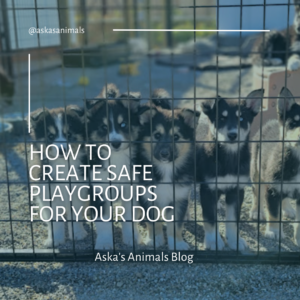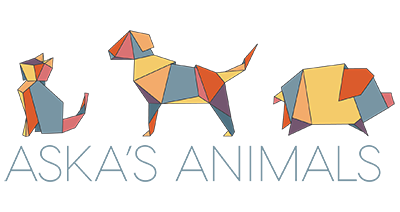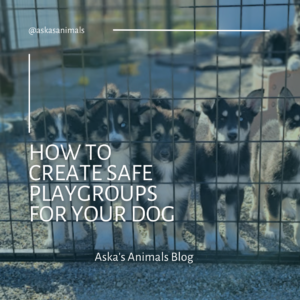How to Create Safe Playgroups for Your Dog
 It’s the time of year that dog owners head to the parks, trails and friend’s houses for barbecues. But what does this mean for your furry friend who you may not want to leave at home? Here’s a list of guidelines to ensure your dog and your dog’s friends are in safe and appropriate playgroups.
It’s the time of year that dog owners head to the parks, trails and friend’s houses for barbecues. But what does this mean for your furry friend who you may not want to leave at home? Here’s a list of guidelines to ensure your dog and your dog’s friends are in safe and appropriate playgroups.
Let’s start with a conversation about choice. Ask your dog, ‘what game do you want to play?’ Obviously, your dog won’t be able to use words to tell you his/her wishes so it’s important to pay attention to their body language. If your dog is excited to see their friend(s) (wagging tag, dancing feet, etc.) that indicates they want to engage in group play. If your dog hides, pulls their ears back or bulges their eyes at the sight of other dogs, group play might not be their preferred form of enrichment. Visit our blog post about other enrichment activities if this is the case!
https://askasanimals.org/indoor-enrichment-activities-for-your-pets-on-winter-days/
If your dog is excited to join the playgroup, here’s a few things to keep in mind:
- Always have a supervisor. Never leave dogs unattended. The supervisor’s job is to keep the arousal level low. If you notice one dog getting over-agitated, competitive or aggressive, step in to distract the animals so the elevated behavior stops until they’re calmed down and can re-engage in more optimal styles of play.
- Watch out for one dog getting their jaw caught in another dog’s collar. If this happens, both dogs might panic causing one dog to be choked and the other to break their jaw. You can remove collars to eliminate this risk. If collars are on, supervise closely to ensure safe play.
- Make sure the dogs have enough space to play. For big dogs, it’s recommended to have at least 100 square feet per dog. For small dogs, 40 square feet per dog will be enough. Never enclose the dogs in a small space like the trunk of a car or a bathroom.
- Group dogs together by size and play style. Just like you wouldn’t expect a toddler who just learned to talk to have fun with a group of teenagers playing charades, a twenty-pound dog won’t have as much fun keeping up with a pack of huskies.
- No matter how well they play, there’s always the risk of a smaller dog getting hurt accidentally. In addition, the high-pitched noises small dogs make while being chased can activate predatory instinct in large dogs.
- Puppies shouldn’t be in large dog play groups either, but a puppy paired with a single socially appropriate adult who enjoys puppies can be a great experience.
- There are four standard play styles to be aware of:
- Neck biting or mouthing – this style of play is when dogs gently mouth other dog’s necks or chins. Usually, it looks like wrestling or rolling around on the ground making playful noises. Dogs who enjoy this style of play don’t bite, they mostly slobber.
- Chasing – this style of play is exactly what it sounds like. Hide and seek, tag you’re it, running hot laps around the yard, etc.
- Body slamming – dogs who enjoy this style play hard and they get physical. Every seen a dog play so hard they fall into a pool or run off a deck? Dogs who like ‘body slam’ play have high pain tolerances and bounce back quickly
- Cat-like – a calm and quiet type of play that involves pawing, rubbing up against the other animals, and running in circles around the dogs doing any of the other three styles.
- Things to watch out for:
- If one dog repeatedly pins another dog down, it’s probably because the pinned dog doesn’t like the body slamming play style. The pinned dog is most likely not having fun so it’s time to intervene.
- If one dog won’t stop playing while the other needs to take a break, separate the dogs every few minutes to give the slower dog a break. Uninterrupted play can become a source of aggression if one dog becomes excessively annoyed with their play partner.
These tips are especially important if you bring your dog to a dog park where many different play styles are represented. If your dog is consistently becoming frustrated with the way other dogs play, consider setting up a playgroup with dogs who have similar play styles.
Like we said at the beginning of this post, it’s important to recognize that not all dogs enjoy playing with other dogs. Many people expect their dog to love playing with other dogs and if their dog doesn’t, the dog is a lemon. This is far from the truth. In puppy classes, dog trainers teach puppies to be comfortable in the presence of other dogs, but playing isn’t required. Often, dogs lose interest in playing with other dogs as they grow up and that’s normal too. Have questions or concerns? Contact Aska’s Animals Dog Behavior Specialist to learn specific tips for your dog and their style of play! If you’re interested in learning more on your own time, check out https://www.shelterdogplay.org which highlights best practices for managing inter-dog play.




